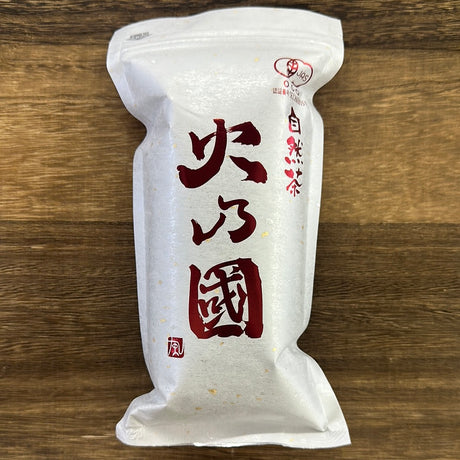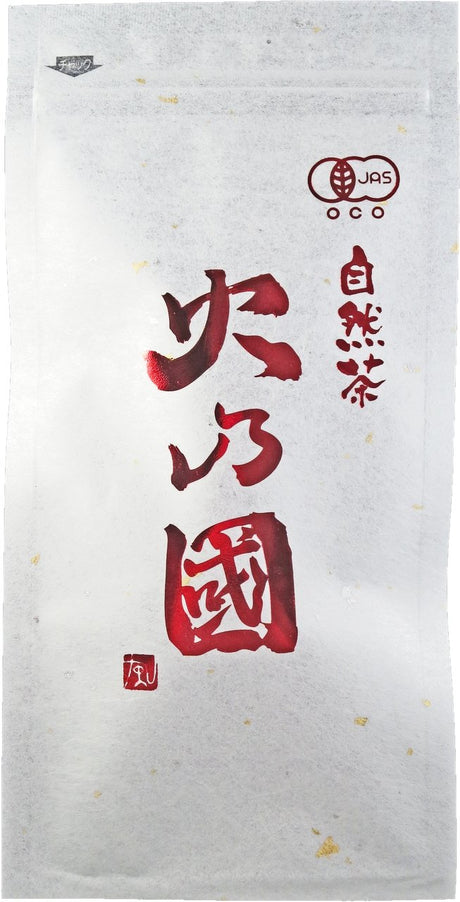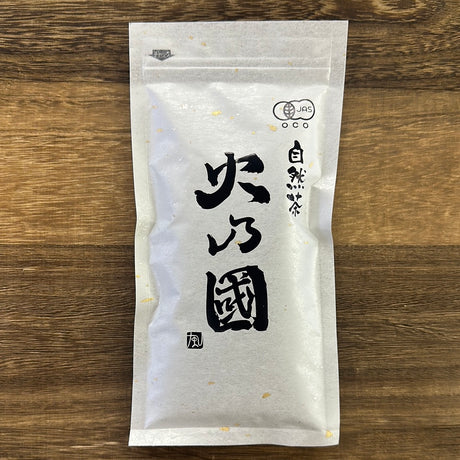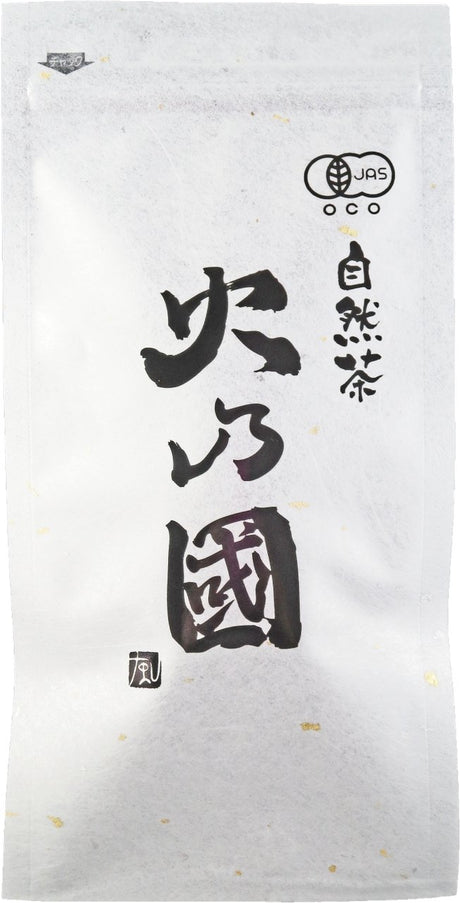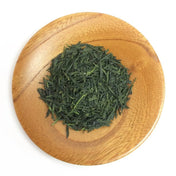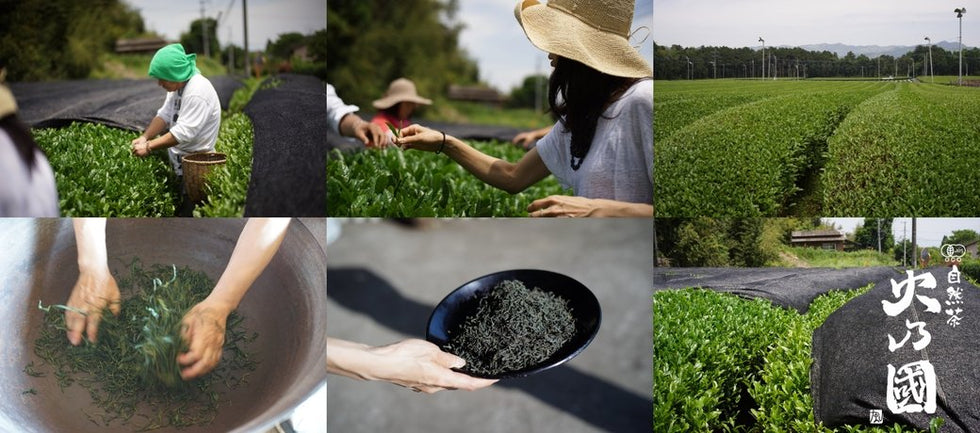
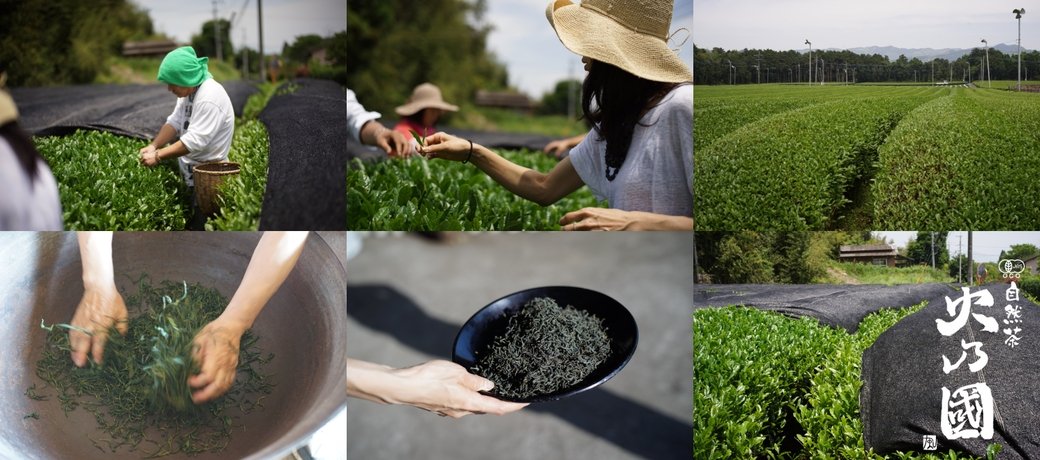

Hinokuni Kumamoto
(2 products)
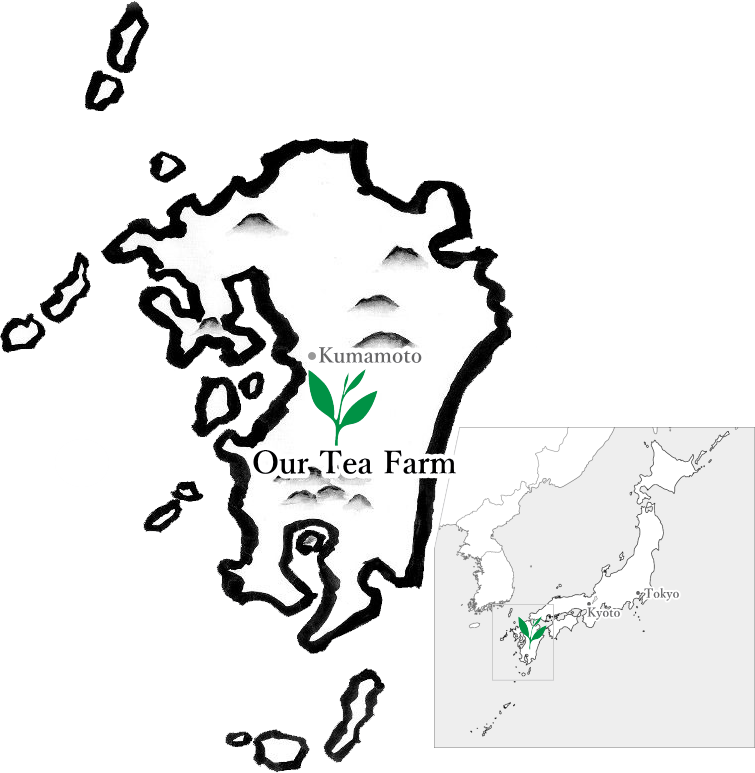
-
Introduction
-
Third generation tea farmer Satoru Fujisako is a dedicated to cultivating clean, organic tea.
- Size: About 8 hectares
- Certification: JAS Organic certified by the Organic Certification Organization Co. Ltd. Tested free from radiation, tested free from pesticide residue annually (262 pesticides tested).
-
Our Story
-
We never use chemicals. Our resolve is ingrained in the history of FUJISAKO TEA ESTATE

About 30 years after the first generation Jyuichiro opened his own tea garden, in 1946 his son Fujisako Tsunao (second generation Jyuichiro) established a tea garden in Sagara Village in the southern part of Kyushu, southwest Kumamoto Prefecture. Known as the "Origin of the Mist", the estate is surrounded on all four sides by mountains rising up 700 meters or more. The extreme temperature difference bewteen morning and night makes this valley the perfect place for growing tea.
Tea cultivation began here when 70 families received 100 sacks containing the seeds of Japanese tea. However, of those 70 households, only 30 were able to grow anything. When the tea leaves eventually budded, only three tea farming households had managed to grow enough to make saleable products. 96% gave up along the way.
Cultivation from seed is truly a difficult task. It takes as many as fifteen years to raise tea to a stage where it’s ready to be plucked. Until then it isn’t clear if the plants will even bud or not. One of the main difficulties is that running a tea estate is an expensive business, especially when you can’t develop any products for the first fifteen years.

In order to pay for the upkeep of his tea fields, the first generation Fujisako tea master Tsunao moved to Tohoku, a region of northwest Japan. He worked in construction for ten years, regularly sending money back home to Sagara on the island of Kyushu, south Japan. At that time, no other tea farmers in Japan were cultivating their tea from the seed.
The cultivation process itself is slow. It takes a long time before merchandise can even start to be made and there will be no income before this. This is the harsh reality of growing tea from the seed.
Passing on the techniques and practices
Fujisako Tea Estate began in 1946 and was inherited by Kenichi Fujisako, second generation tea master and son to Tsunao, in 1976.
In 1945, after Japan’s defeat in the war, everything in Japan, from politics to the economy, was conducted in accordance with American policies. One of those policies concerned mass consumption and mass production through the use of pesticides and chemical fertilizers.
In America the damage caused by such chemicals had already become a serious problem. Widespread use in America shifted the weight of public opinion against the application of chemicals and their use had to be minimized. Plummeting sales signaled a make-or-break situation for the the major distributors in agrochemicals and pharmaceuticals. Their attention turned overseas – to Japan. If they couldn’t sell their chemicals at home, then they would have to sell them abroad. This phenomenon still continues to this day.
Everyone had to follow the orders of certain groups involved in the tea trade without question. If pesticides and chemical fertilizers were not purchased, deals would not be brokered and no financing could be received. Fujisako Tea Estate was no exception, but the second generation tea master Kenichi refused anyway.
"Pesticides and chemical fertilizers are a danger to human health and damaging to the environment. But if sales go up, surely it’s fine to use them." While contemplating the pros and cons of their use, Kenichi suffered damages due to chemical fertilizers and pesticides and his business was brought to the verge of bankruptcy. That was in 1977. It was then that Kenichi made his mind up.
Tea processing machines inside the factory


These tea machines were installed over 50 years ago and are still in use to this day. If it ain’t broke, don’t replace it” – the mindset of the Japanese people when it comes to machinery. Whether it’s people, material items or nature, we must treat everything with the respect it deserves.
"I will absolutely never use chemicals!"
Kenichi took the first chemical free step in 1978. As soon as he stopped using chemicals, the estate was hit by an epidemic. Yields fell sharply and the tea tasted terrible. The price slipped to almost nothing. Even so, he still didn’t use chemicals! That’s how strongly Kenichi felt.
Neighbors would mock him, saying things like, "Kenichi’s a fool, doesn’t he know any better?" or "He doesn’t use nitrogen fertilizer. He won’t grow tea that way. What an idiot".
He was virtually outcast.
First Kenichi removed the remaining chemical fertilizers and pesticides from the soil using electrolysis. He wanted to return the estate to its natural state as fast as possible. Electrolysis on a farm of 8 hectares cost somewhere in the region of ¥2 million, but somehow, Kenichi gathered the funds.
Even after the electrolysis treatment, he still couldn’t produce any tea. He had to leave the field to recover for seven years. The estate became infested with bugs. Weeds grew unrestrained, but not tea.
The neighbors began again, "Fujisako’s tea farm is overgrown with weeds. He’s either given up growing tea or gone mad".
Kenichi persevered and persevered, unmoved by such words, and at last, in the tea harvesting season of the eighth year, he could finally start production.
"Ah, it’s back! At long last it’s back!" And so it was. Little by little the tea growing conditions improved.

Tea Flowers
The white petals and yellow stamens are the flowers’ trademark. These tea trees have continued to propagate their seeds since ancient times, pollinated by wind borne pollen from other regions. The tea plants bear seeds from October through November.

Nurturing the innate power of the tea
We trust the growing to the tea!
This is what Kenichi was able to appreciate. The idea is to leave the tea’s growth to the forces of Nature. There never used to be any dependence on chemical fertilizers or agricultural chemicals. Everything simply returned to Nature.
As for the tea produced with these methods, the quality had risen high enough to claim the Minister for Agriculture, Forestry and Fisheries Prize in 1986.
We passed the residual chemical detection test and were awarded "Clear"in every category
It took almost 60 years since 1946 when actual cultivation began to reach so far.

On the street there are many goods that sell "pesticide" in 5 years of absence, but this tea garden has a different history.And this tea garden is surrounded by big mountains on all sides, is in an environment protecting from scattered poisons from the surroundings, and the wind flowing from the northwest does not collect volcanic ash from Sakurajima and Kirishima located in the southeast . Even in Japan, there will be no tea garden environment protected so far.
It is this tea plant started from seedling cultivation since 1946, but 72 years (as of 2018) have passed since planting seeds.
That species is a rare species that has not taken place such as breed improvement, which has inherited the ancient genes.
Although it is said that Eizai brought tea seeds and manufacturing methods from China and spread, it is said that it is the beginning of Japanese tea, but the tea garden is located in the Sagara-mura Kumamoto It is said that one of the most famous ancient tea in Japan (Yamacha) is a land native to it.
In fact, recently I realized that Sawanishi brought in "Chinese style tea making method (Aoyagi method)".
In the tea ceremony story recorded by Sakaishi, it is stated that Eizai himself was popularized, and it is being understood in modern way as it is.
However, please calmly think, "Is there really no tea tree in Japan until Eizai brought in?"
Actually, the historical book "Kuma County History" in Kuma-gun with Sagara-mura has the following description.
"· · · However, there is also a description that there was already tea as" medicinal "in Japan from the era of Shomu Emperor (AD701-756) about 500 years ago In view of calmness, the probability that "tea was present in Japan from ancient times" is considered to be high.
【Kuma County History Volume P245】
Emperor Shomu 's era is about 500 years ago when Eizai is active.
The fact that tea comes out already in the description of that era is probably more natural to think that Yamacha was growing up naturally in mountains nationwide (especially in the west of Tokyo) in Japan.
For example, we are manufacturing semi-fermented tea (oolong tea) using Yamasha in our tea room. Moreover, it was at least 20 years ago that Kenichi began manufacturing for the first time.

However, one of the farmers said that "I started making oolong tea for the first time in Japan," and now it is often sold at organic shops.
If it says "I am the first time" it is until then. Perhaps, the description of Eizai's coffee cup regimen may have been similar to that.
In addition to tea, plants frequently used in Japanese traditional Japanese medicine such as "Kakidoshi" "Yomogi" "Narukoyuri" are also naturally native around our tea room.
There are also a large number of wild vegetables such as Zenmai and Warabi and in season everyone goes to a tea room, takes wild vegetables such as Zenmai · Warabi · Taranome and goes back to the factory to tempura and eat it.
Also, as a special food only for the new tea season, there is "New tea leaf tempura".
Since this eats raw tea leaves as it is, it is needless to say that it is absolutely necessary to be "leaf of non-pesticide-cultivated tea".
This tea plant is living as it is as well as tea as well as tea.
Depending on the time, you can also see wild birds such as pheasant, deer and uribou(boar).
-
About the Hinokuni Region of Kumamoto
-
Location of the plantation
Hitoyoshi Basin located at the southern tip of Kumamoto prefecture. In the mortar shaped basin, tea is produced on a plateau of 230 m above sea level built over the years.
It was a flat land up to about 100 million years ago, due to repeated crustal deformation, the whole area of Kuma-gun collapses to form a mortar-shaped basin.
The land surrounded by mountains 360 degrees escaped from many wars, Mr. Sagara who was in this place was appointed to the stature in the 3rd year (1193) of the Kamakura period and then as the lord of the Hitoyoshi clan , Until the Meiji Restoration of Keio 3 rd year (1868), it has been a very rare area in Japan that has kept a long period of 675 years.

Kawabegawa: The Kawanabe River, which flows near this tea plant, is the largest tributary of the Kumagawa River system, one of the three rapids in Japan, and it is a first-class river flowing in the southern part of Kumamoto Prefecture. It originated from the Itsuki River of Kunimutake located in the boundary between Kumamoto Prefecture and Miyazaki Prefecture, merged with Itsuki River in the Itsukimura of Kumamoto Prefecture Kumamoto Prefecture, Kawabe River. National Route 445 flows in the southwest in parallel, and joins the Kumagawa river in the Hitoyoshi Basin.
The Kumagawa river and Kawanabe river are beautiful rivers rich in water volume that natural ayu and Yamame inhabit, and you can enjoy thrilling rafting using the rapids in the Kumagawa river. From the Kuma area to the Yatsushiro plain of the estuary, we benefit from underground water in the Kyushu mountainous area and the rich and clean water resources of the Kawanabe and Kumagawa rivers.

A stone monument in Miyahara SA in the direction of Fukuoka going up from Kyushu Expressway Hitoyoshi interchange. It was divided into The Hinokuni from a country of fertilizer, and it was divided into Hizen and Higo, later Kumamoto prefecture was called Higo later.

Handmade crafts of famous products. It is also called a pheasant car (Kiji Guruma). Simulate wild bird's pheasant with rustic wooden toy, make it by cutting wood, attach wheels and strings, tow the outdoor and play. Kijima is mainly produced in the Kyushu region, but what is produced in the Hitoyoshi region is called Hitoyoshi type.

Take the Kyushu Expressway Hitoyoshi interchange and turn left at the traffic light. Turn left at the next traffic light and enter Fur tee Road. There is a plateau where a tea field spreads about 20 km straight from there. This place is located at a corner of the plateau.
- Featured
- Best selling
- Alphabetically, A-Z
- Alphabetically, Z-A
- Price, low to high
- Price, high to low
- Date, old to new
- Date, new to old
FiltersFilter & Sort
Hinokuni Kumamoto
Hinokuni Kumamoto: Organic 15-year Aged Japanese Oolong Tea - Aka
★★★★★(6)From €2,63 EURUnit price /UnavailableIn stock (9 units)Hinokuni Kumamoto
Hinokuni Kumamoto: Dark Roast Hojicha - Kuro
★★★★★(1)From €2,60 EURUnit price /UnavailableIn stock (7 units)

